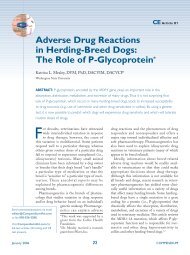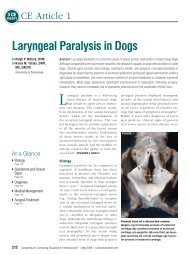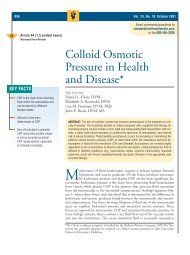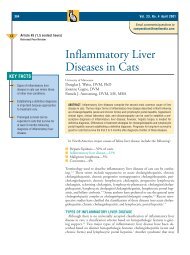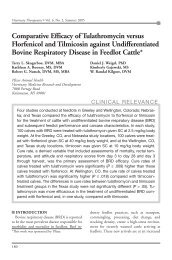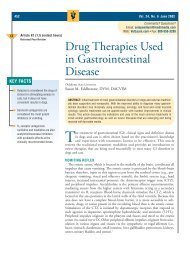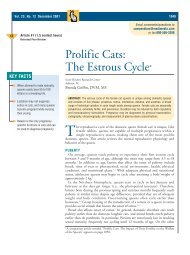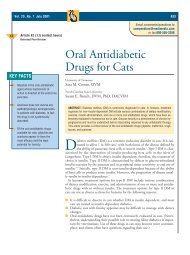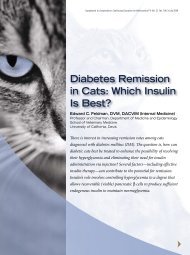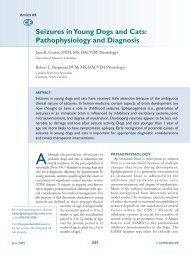EMERGENCY AND CRITICAL CARE MEDICINE® - VetLearn.com
EMERGENCY AND CRITICAL CARE MEDICINE® - VetLearn.com
EMERGENCY AND CRITICAL CARE MEDICINE® - VetLearn.com
Create successful ePaper yourself
Turn your PDF publications into a flip-book with our unique Google optimized e-Paper software.
Peer Reviewed<br />
SEPTEMBER 2006<br />
ST<strong>AND</strong>ARDS of <strong>CARE</strong><br />
<strong>EMERGENCY</strong> <strong>AND</strong> <strong>CRITICAL</strong> <strong>CARE</strong> MEDICINE ®<br />
FROM THE PUBLISHER OF COMPENDIUM<br />
EXTRAHEPATIC BILIARY OBSTRUCTION<br />
Philipp Mayhew, BVM&S, MRCVS, DACVS<br />
Assistant Professor of Small Animal Surgery<br />
Department of Clinical Studies<br />
School of Veterinary Medicine<br />
University of Pennsylvania<br />
Extrahepatic biliary obstruction (EHBO) is an<br />
un<strong>com</strong>mon diagnosis in veterinary patients; however,<br />
when seen, EHBO is often associated with<br />
significant systemic <strong>com</strong>promise that can present a<br />
considerable diagnostic and therapeutic challenge. A<br />
variety of underlying disease processes can be the<br />
cause of obstruction, so a thorough diagnostic evaluation<br />
of the patient is required. The underlying cause<br />
may significantly affect the prognosis as well as the<br />
approach to therapy.<br />
The most <strong>com</strong>mon causes of EHBO in dogs are<br />
pancreatitis, neoplasia, biliary mucoceles, cholangitis,<br />
and cholelithiasis. In cats, a <strong>com</strong>plex of<br />
inflammatory diseases that includes pancreatitis,<br />
cholangiohepatitis, cholecystitis with or without<br />
cholelithiasis, and neoplasia is most <strong>com</strong>monly<br />
responsible. Other less <strong>com</strong>mon causes in cats<br />
include parasitic infection, diaphragmatic hernia,<br />
and foreign body obstruction.<br />
Patients with EHBO often have multisystemic<br />
organ dysfunction, much of which has been attributed<br />
to the occurrence of systemic endotoxemia in<br />
humans and experimental animal models. It is<br />
hypothesized that the absence of bile salts in the<br />
intestinal tract leads to bacterial overgrowth and<br />
endotoxin absorption. Impaired clearance of endotoxins<br />
caused by impaired reticuloendothelial function<br />
is also thought to contribute to the development<br />
of systemic endotoxemia. Impaired myocardial contractility,<br />
hypotension, coagulopathies, gastrointestinal<br />
hemorrhage, renal dysfunction, and delayed<br />
wound healing have all been shown to result. Aggressive<br />
supportive therapy as well as early surgical intervention<br />
is advised in most patients because they<br />
rapidly be<strong>com</strong>e systemically <strong>com</strong>promised.<br />
DIAGNOSTIC CRITERIA<br />
Historical Information<br />
Gender Predisposition<br />
• There are no known gender predispositions for any<br />
of the individual underlying diseases known to<br />
cause EHBO.<br />
Age Predisposition<br />
• A very wide age range of animals can be affected,<br />
although certain underlying diseases can be associated<br />
with certain age groups.<br />
— Neoplasia is usually seen in older patients,<br />
although some animals as young as 2 years of<br />
age can be affected.<br />
— Biliary mucoceles are seen in dogs 3 to 15 years<br />
of age with a median age of 10 to 11 years. Biliary<br />
mucoceles are not reported in cats.<br />
• In cats, a very wide age range has been reported for<br />
all causes of EHBO.<br />
Breed Predisposition<br />
• No breed predispositions have been noted in either<br />
dogs or cats.<br />
Owner Observations<br />
• Icterus.<br />
• Lethargy.<br />
• Anorexia.<br />
Also in this issue:<br />
9 Cancer Cachexia as a Manifestation of<br />
Malignancy<br />
VOL 8.8<br />
1
2<br />
• Vomiting.<br />
• Weight loss.<br />
Other Historical Considerations/Predispositions<br />
• Clinical signs often wax and wane, and patients may be presented several<br />
weeks or months after the clinical signs begin.<br />
Physical Examination Findings<br />
• Icterus.<br />
• Weight loss.<br />
• Dehydration.<br />
• Ascites.<br />
• Palpable cranial abdominal mass.<br />
• Diarrhea.<br />
Laboratory Findings<br />
• Hyperbilirubinemia (reference range: dogs, 0.3–0.9 mg/dl; cats, 0.1–0.8<br />
mg/dl).<br />
• Increased serum alkaline phosphatase (reference range: dogs, 20–155<br />
U/L; cats, 22–87 U/L).<br />
• Increased serum alanine aminotransferase (reference range: dogs, 16–91<br />
U/L; cats, 33–152 U/L).<br />
• Increased γ-glutamyl transferase (reference range: dogs, 7–24 U/L; cats,<br />
5–19 U/L).<br />
• Leukocytosis (reference range: dogs, 5.3–19.8 × 10 3 /µl; cats, 4–18.7 × 10 3 /µl).<br />
• Hypercholesterolemia: Less <strong>com</strong>mon in cats (reference range: dogs,<br />
128–317 mg/dl; cats, 96–248 mg/dl).<br />
• Hypoalbuminemia (reference range: dogs, 2.5–3.7 g/dl; cats, 2.4–3.8 g/dl).<br />
• Urinalysis: Bilirubinuria or bilirubin crystals in the urine are <strong>com</strong>mon.<br />
• Coagulation profile: One-step prothrombin time (OSPT) and the PIVKA<br />
(proteins induced by absence of vitamin K) test are the most sensitive early<br />
coagulation tests but are often not abnormal until 10 to 14 days after<br />
obstruction. Often in chronic cases, evidence of a mixed hemostatic disorder<br />
with increases in OSPT and activated partial thromboplastin time<br />
along with thrombocytopenia can indicate disseminated intravascular<br />
coagulation.<br />
• Fecal examination: Acholic feces are occasionally found in patients with<br />
<strong>com</strong>plete biliary obstructions because of a <strong>com</strong>plete lack of bile pigments<br />
in the intestines. Evidence of trematode eggs in the feces may indicate<br />
fluke infestation, which is a reported cause of EHBO, especially in cats.<br />
Other Diagnostic Findings<br />
• Radiography: Plain radiographs cannot be used to diagnose EHBO but may<br />
show a space-occupying lesion in the cranial abdomen that may be evidence<br />
of an enlarged gallbladder or a mass. Approximately 50% of canine<br />
choleliths and more than 80% of feline choleliths are radiopaque and may<br />
be visible on abdominal radiography. Choleliths may be seen in the gall-<br />
KEY TO COSTS<br />
$ indicates relative costs of any diagnostic and treatment regimens listed.<br />
$ costs less than $250<br />
$$ costs between $250 and $500<br />
$$$ costs between $500 and $1,000<br />
$$$$ costs more than $1,000<br />
S E P T E M B E R 2 0 0 6 V O L U M E 8 . 8<br />
SEPTEMBER 2006 VOL 8.8<br />
ST<strong>AND</strong>ARDS of <strong>CARE</strong><br />
<strong>EMERGENCY</strong> <strong>AND</strong> <strong>CRITICAL</strong> <strong>CARE</strong> MEDICINE ®<br />
Editorial Mission:<br />
To provide busy practitioners with concise,<br />
peer-reviewed re<strong>com</strong>mendations on current<br />
treatment standards drawn from published<br />
veterinary medical literature.<br />
This publication acknowledges that standards<br />
may vary according to individual experience<br />
and practices or regional differences. The<br />
publisher is not responsible for author errors.<br />
Compendium’s Standards of Care:<br />
Emergency and Critical Care Medicine®<br />
is published 11 times yearly<br />
(January/February is a <strong>com</strong>bined issue)<br />
by Veterinary Learning Systems,<br />
780 Township Line Road, Yardley, PA 19067.<br />
The annual subscription rate is $83.<br />
For subscription information, call<br />
800-426-9119, fax 800-589-0036,<br />
email soc.vls@medimedia.<strong>com</strong>, or visit<br />
www.SOCNewsletter.<strong>com</strong>. Copyright<br />
© 2006, Veterinary Learning Systems.<br />
Editor-in-Chief<br />
Douglass K. Macintire, DVM, MS,<br />
DACVIM, DACVECC<br />
334-844-4690<br />
macindk@vetmed.auburn.edu<br />
Group Publisher<br />
Ray Lender<br />
267-685-2417<br />
rlender@medimedia.<strong>com</strong><br />
Editorial, Design, and Production<br />
Lilliane Anstee, Vice President,<br />
Editorial and Design<br />
Maureen McKinney, Editorial Director<br />
Cheryl Hobbs, Senior Editor<br />
Danielle Shaw, Editor<br />
Michelle Taylor, Senior Art Director<br />
Bethany L. Wakeley, Studio Manager<br />
Chris Reilly, Assistant Editor<br />
Andrea Vardaro Tucker, Editorial Assistant<br />
Editorial Review Board<br />
Mark Bohling, DVM<br />
University of Tennessee<br />
Harry W. Boothe, DVM, DACVS<br />
Auburn University<br />
Derek Burney, DVM, PhD, DACVIM<br />
Houston, TX<br />
Joan R. Coates, DVM, MS, DACVIM<br />
University of Missouri<br />
Curtis Dewey, DVM, DACVIM, DACVS<br />
Plainview, NY<br />
Nishi Dhupa, DVM, DACVECC<br />
Cornell University<br />
D. Michael Tillson, DVM, MS, DACVS<br />
Auburn University
ladder or may be visualized in the bile duct,<br />
although their causative role in EHBO cannot be<br />
assessed. Biliary mucoceles may, if large, be visualized<br />
as a large soft tissue opacity in the cranial<br />
abdomen. If EHBO has culminated in rupture of the<br />
biliary tract and bile peritonitis, there may be a loss<br />
of detail on abdominal radiographic views. $<br />
• Abdominal ultrasonography: Abdominal ultrasonography<br />
is an excellent imaging technique used to<br />
evaluate the biliary tract in dogs and cats. The normal<br />
diameter of the bile duct is approximately 2 to<br />
4 mm in dogs and cats. One of the earliest signs of<br />
EHBO is distension of the bile duct, which occurs<br />
within 48 hours, soon followed by distension of the<br />
hepatic ducts with intrahepatic duct distension present<br />
within 1 week in most cases.<br />
— It should be noted that ultrasonographic distension<br />
of the biliary tree does not indicate active<br />
obstruction because long-term persistence of<br />
distension can result from a previous episode of<br />
EHBO. Monitoring the degree of obstruction<br />
over several days may be helpful in discerning<br />
active obstruction from a previous episode.<br />
— Patients with gallbladder mucoceles frequently<br />
present with enlarged gallbladders that have a<br />
typical immobile stellate or finely striated<br />
ultrasonographic appearance (the so-called<br />
kiwi gallbladder). Choleliths can usually be<br />
identified by their focal echogenic appearance<br />
and acoustic shadowing. The area around the<br />
major duodenal papilla is a <strong>com</strong>mon location<br />
for obstructive lesions and should be evaluated<br />
thoroughly for evidence of neoplasia, pancreatitis,<br />
or choleliths causing EHBO. $–$$<br />
• Hepatobiliary scintigraphy: A variety of radiopharmaceutical<br />
agents have been used for hepatobiliary<br />
scintigraphy in both dogs and cats, including<br />
99m technetium–diisopropyl iminodiacetic acid and<br />
99m technetium-mebrofenin for hepatobiliary scintigraphy.<br />
Scintigraphic evaluation of hepatic uptake,<br />
biliary accumulation, and excretion into the intestine<br />
is performed. Nonvisualization of the intestine<br />
by 3 hours after radiopharmaceutical injection is<br />
used as the scintigraphic criterion for diagnosis of<br />
EHBO. The main disadvantage of scintigraphy is<br />
that it is incapable of giving accurate information<br />
as to the exact site or cause of obstruction. Specialized<br />
equipment and expertise are required.<br />
Local radiation safety protocols for handling animals<br />
administered radiopharmaceuticals must also<br />
be observed. $$–$$$$<br />
• Computed tomography and magnetic resonance<br />
imaging: Advanced imaging techniques will likely<br />
be used more frequently to evaluate the biliary tract<br />
in the future, although little information on their use<br />
is available in the veterinary literature. $$$–$$$$<br />
ST<strong>AND</strong>ARDS of <strong>CARE</strong>: <strong>EMERGENCY</strong> <strong>AND</strong> <strong>CRITICAL</strong> <strong>CARE</strong> MEDICINE<br />
ON THE NEWS FRONT<br />
— Endoscopic placement of biliary stents is the<br />
subject of current research in the veterinary<br />
field and is <strong>com</strong>mon in human medicine. It<br />
may allow an additional definitive treatment<br />
modality in select cases or may allow<br />
preoperative drainage in others, which<br />
could decrease morbidity and mortality<br />
rates in EHBO surgery in the future. This is<br />
yet to be proven.<br />
• Endoscopic retrograde cholangiopancreatography:<br />
Used extensively for both diagnostic and therapeutic<br />
interventions in humans, this technique has now<br />
been described in dogs and is likely to be<strong>com</strong>e routine<br />
in the future. After catheterization of the major<br />
duodenal papilla, injection of iodinated contrast<br />
agent allows visualization of both the pancreatic<br />
duct system and the biliary tract. Therapeutic interventions,<br />
such as cholelith removal or stent placement,<br />
may also be possible in the future after a<br />
diagnosis has been established. $$–$$$<br />
• Abdominocentesis: If abdominal effusion is present,<br />
obtaining a sample by abdominocentesis is vital to<br />
rule out bile peritonitis. The most <strong>com</strong>mon causes<br />
of biliary leakage and secondary bile peritonitis are<br />
an increase in intracolic pressure secondary to<br />
EHBO and direct perforation by a cholelith or neoplasm<br />
that has eroded through the wall of the bile<br />
duct. If the bilirubin concentration of the abdominal<br />
fluid is two or more times greater than that in the<br />
serum, bile peritonitis is likely to be present. $<br />
• Exploratory laparotomy: Exploratory laparotomy<br />
should be considered an important part of the diagnostic<br />
plan, especially if diagnostic imaging findings<br />
are equivocal but clinical signs or laboratory<br />
findings are still suggestive or if diagnostic imaging<br />
is unavailable. Palpation of the gallbladder can<br />
often allow assessment of obstruction, which is usually<br />
ac<strong>com</strong>panied by bile duct distension. If gallbladder<br />
palpation does not allow assessment of<br />
patency or if there is a discontinuity to the biliary<br />
tract resulting in bile leakage upon palpation of the<br />
gallbladder, catheterization of the biliary tract is<br />
necessary to assess patency. Catheterization can<br />
either be performed normograde or retrograde using<br />
a 5- to 12-Fr red rubber catheter, depending on the<br />
size of the patient. Either a catheter can be passed<br />
from the gallbladder down the bile duct to enter the<br />
duodenum (normograde) or a 3- to 4-cm antimesenteric<br />
duodenotomy over the area of the major<br />
duodenal papilla, 3 to 5 cm aboral to the pylorus,<br />
can be performed. The catheter can then be passed<br />
retrograde up through the bile duct into the gallbladder.<br />
$$$–$$$$<br />
3
4<br />
CHECKPOINTS<br />
—The timing of surgery can be controversial,<br />
especially in patients with pancreatitis-related<br />
EHBO, because medical management may<br />
lead to resolution of signs after a period of<br />
time. In my experience, although this can<br />
occur, most cases require surgical<br />
intervention, and this is best performed<br />
early in the course of the disease.<br />
—When cholelithiasis is the cause of EHBO,<br />
performance of a cholecystectomy to<br />
prevent recurrence is often considered,<br />
even if the gallbladder is still healthy. In<br />
my view, this is justifiable based on the<br />
observation that recurrence has not been<br />
recorded in the veterinary literature in<br />
patients with cholelithiasis when a<br />
cholecystectomy was performed;<br />
furthermore, the procedure is performed<br />
routinely in humans with gallstone disease.<br />
A controlled study in the veterinary<br />
literature that lends support to this<br />
anecdotal opinion is lacking at this time.<br />
—Although bile acids are usually significantly<br />
elevated both pre- and postprandially in<br />
patients with EHBO, elevations can be the<br />
result of any type of liver disease. Therefore,<br />
measuring bile acids is not routinely<br />
performed in the author’s institution for<br />
patients with EHBO.<br />
Summary of Diagnostic Criteria<br />
• History of lethargy, anorexia, vomiting, and weight<br />
loss.<br />
• Physical examination may show icterus, dehydration,<br />
pain on abdominal palpation, and possibly<br />
ascites with or without evidence of a cranial<br />
abdominal mass effect.<br />
• Hyperbilirubinemia.<br />
• Elevated serum levels of cholestatic enzymes (alkaline<br />
phosphatase, γ-glutamyl transferase).<br />
• Diagnostic imaging evidence of progressive biliary<br />
tract distension, most <strong>com</strong>monly through ultrasonographic<br />
or scintigraphic studies.<br />
Diagnostic Differentials<br />
• Prehepatic icterus is the result of hemolytic disease<br />
and can be caused by a variety of underlying factors.<br />
Differentiation between pre- and posthepatic<br />
icterus is ac<strong>com</strong>plished through evaluation of<br />
hematocrit, erythrocyte morphology, liver enzymes,<br />
and the results of diagnostic imaging of the biliary<br />
tract. Fractionation of total bilirubin into conjugated<br />
S E P T E M B E R 2 0 0 6 V O L U M E 8 . 8<br />
and unconjugated bilirubin is not helpful in small<br />
animals.<br />
• Primary hepatic disease caused by inflammatory,<br />
infectious, degenerative, or neoplastic processes<br />
can mimic the clinical signs of extrahepatic biliary<br />
diseases. These can usually be differentiated using<br />
serum biochemical evaluation and diagnostic imaging.<br />
Inflammatory disease of the liver often ac<strong>com</strong>panies<br />
extrahepatic biliary diseases, especially in<br />
cats, in which an inflammatory disease <strong>com</strong>plex<br />
involving the intestine, pancreas, biliary tract, and<br />
liver exists. Involvement of the liver in extrahepatic<br />
biliary disease or primary hepatic disease should be<br />
assessed by either ultrasonography-guided aspiration<br />
or needle biopsy of the liver or by collection of<br />
biopsy samples at laparotomy.<br />
TREATMENT<br />
RECOMMENDATIONS<br />
Initial Treatment<br />
• Initial patient stabilization: Many patients with<br />
EHBO present late in the course of their disease<br />
process. They are often systemically <strong>com</strong>promised<br />
and require hemodynamic resuscitation before surgical<br />
intervention.<br />
• Fluid therapy: Fluid therapy should be instituted<br />
promptly. An estimate of the fluid deficit should be<br />
made based on degree of dehydration (assessed by<br />
degree of skin tenting and dryness of mucous<br />
membranes) and hemodynamic parameters such<br />
as heart rate, pulse quality, capillary refill time,<br />
temperature of the extremities, and (if possible)<br />
measurement of arterial blood pressure and central<br />
venous pressure.<br />
The fluid deficit is replaced with an isotonic crystalloid<br />
solution (Normosol-R, Plasmalyte). Solutions<br />
with bicarbonate precursors, such as lactate (lactated<br />
Ringer’s) and acetate (Normosol-R, Plasmalyte),<br />
are alkalinizing and are especially useful in<br />
patients with metabolic acidosis, which is <strong>com</strong>monly<br />
found in patients with EHBO.<br />
The rate of fluid administration varies widely<br />
based on the degree of hemodynamic <strong>com</strong>promise.<br />
Dogs with mild to moderate hypovolemic shock<br />
can be administered fluids rates of 30 to 60 ml/kg<br />
for the first hour. Fluid dose rates in cats are generally<br />
reduced by one-third to one-half. In cases of<br />
severe hypovolemic shock, up to 90 ml/kg/hr in<br />
dogs and 60 ml/kg/hr in cats can be given initially.<br />
Intercurrent respiratory or cardiac <strong>com</strong>promise<br />
should be ruled out before administering large volumes<br />
of fluids. After replacement, maintenance<br />
fluid (isotonic crystalloid solution) can be administered<br />
at 10 ml/kg/hr during surgery. In patients with<br />
low colloid oncotic pressure, a colloid such as dex-
tran (dogs, 10–20 ml/kg; cats, 5–10 ml/kg) or hetastarch<br />
(dogs, 10–20 ml/kg; cats, 5–10 ml/kg;<br />
boluses of 5 ml/kg can be given to dogs and by slow<br />
infusion over 30 minutes to cats) may be necessary<br />
to maintain vascular volume. The need for colloid<br />
administration may be assessed by monitoring<br />
serum albumin, total protein, or, ideally, direct<br />
measurement of colloid oncotic pressure. $<br />
• Antimicrobial administration: Positive cultures of<br />
bile in patients with EHBO have been recorded in<br />
38% of dogs and 50% of cats in previous studies.<br />
Many different bacteria have been cultured, including<br />
Escherichia coli, Clostridium spp, Enterococcus<br />
spp, and Bacteroides spp, among others. IV antimicrobial<br />
coverage should be initiated soon after diagnosis<br />
because bactibilia is <strong>com</strong>mon and associated<br />
with an increased mortality rate in cases with concurrent<br />
bile peritonitis and potentially associated<br />
with higher wound infection rates postoperatively.<br />
Empirically selected antimicrobial agents should be<br />
broad spectrum with good action against enteric<br />
gram-negative and anerobic bacteria and preferably<br />
be excreted in bile. A second-generation cephalosporin<br />
(e.g., cefoxitin, 15 mg/kg IV tid for dogs and<br />
cats) is a suitable choice, although it lacks efficacy<br />
against enterococci. Ampicillin (22 mg/kg IV tid for<br />
dogs and cats) can be added to widen the spectrum<br />
to include Enterococcus spp. $<br />
• Blood products: Results of coagulation tests dictate<br />
the need for blood products to supplement<br />
fluid therapy in the resuscitation regimen. Freshfrozen<br />
plasma should be administered at a rate of<br />
10 ml/kg q4–6h as needed in animals with laboratory-demonstrated<br />
coagulopathy or excessive surgical<br />
bleeding. In animals that are anemic, packed<br />
erythrocytes (at a dose of 10 ml/kg) can be used.<br />
Whole blood is especially useful in patients with<br />
concurrent coagulopathy because it contains<br />
active coagulation factors as well as erythrocytes.<br />
A dose of 2 ml/kg of whole blood increases the<br />
packed cell volume (PCV) by about 1%. The formula<br />
shown in the box on page 6 can be used to<br />
estimate the dose of whole blood. $$–$$$<br />
• Vitamin K supplementation: Because of the<br />
absence of bile salts in the intestines of patients<br />
with EHBO, fat emulsification is impaired, leading<br />
to malabsorption of vitamin K. This results in<br />
decreased activation of vitamin K–dependent<br />
coagulation factors II, VII, IX, and X. If the results<br />
of coagulation tests are normal, there may be no<br />
need for supplementation. However, if there is<br />
clinical bleeding or laboratory evidence of vitamin<br />
K–dependent coagulopathy (increased prothrombin<br />
time or PIVKA), then supplementation is<br />
advised. Vitamin K is administered at 0.1 to 0.2<br />
mg/kg SC sid. $<br />
ST<strong>AND</strong>ARDS of <strong>CARE</strong>: <strong>EMERGENCY</strong> <strong>AND</strong> <strong>CRITICAL</strong> <strong>CARE</strong> MEDICINE<br />
Alternative/Optional<br />
Treatments/Therapy<br />
Surgical Management $$$–$$$$<br />
In patients with demonstrated EHBO, surgical management<br />
should not be delayed beyond the period of<br />
resuscitation. In rare cases, it is possible for pancreatitis-induced<br />
EHBO to be responsive to medical management<br />
and be reversible, but in my experience this<br />
is unusual, and many cases require surgical de<strong>com</strong>pression.<br />
In general, if an inability to demonstrate<br />
patency of the bile duct by normograde or retrograde<br />
catheterization of the duct exists, a cholecystoenterostomy<br />
should be considered. The procedure of choice<br />
is a cholecystoduodenostomy, which maintains more<br />
normal gastrointestinal physiology than cholecystojejunostomy.<br />
In some cases, however, excessive tension<br />
is encountered when an attempt is made to anastomose<br />
the gallbladder to the duodenum, mandating the<br />
use of the jejunum in the anastomoses. Because the<br />
normal bile duct has a small lumen (only 2–4 mm in<br />
diameter in cats), choledochoduodenostomy is ill<br />
advised except in <strong>com</strong>plex cases in which both passage<br />
of bile through the major duodenal papilla or a<br />
cholecystoenterostomy are impossible (e.g., cases of<br />
EHBO ac<strong>com</strong>panied by gallbladder necrosis) and significant<br />
ductal dilation exists.<br />
In cases in which patency of the bile duct can be<br />
shown by catheterization but biochemical and diagnostic<br />
imaging tests have confirmed functional EHBO,<br />
biliary stenting can be considered. Biliary stenting is an<br />
option in patients with potentially reversible disease<br />
processes (e.g., pancreatitis), in those with trauma to<br />
the bile duct, and as a palliative measure in patients<br />
with neoplasia.<br />
Another option for temporary rerouting of the biliary<br />
system is the placement of a cholecystostomy tube<br />
that drains bile through the body wall to a closed collection<br />
system. This can be helpful in the management<br />
of pancreatitis-related EHBO if resolution of the pancreatitis<br />
is anticipated in time. Cholecystectomy is<br />
advised in cases of cholelithiasis, biliary mucocele,<br />
gallbladder neoplasia, or trauma to the gallbladder if<br />
patency of the bile duct can be confirmed.<br />
Cholecystoduodenostomy<br />
The patient is positioned in dorsal recumbency and<br />
prepared for aseptic surgery. A full exploratory laparotomy<br />
is performed. After a decision has been made to<br />
perform a cholecystoduodenostomy, the gallbladder<br />
must be dissected from its hepatic fossa to allow <strong>com</strong>plete<br />
mobilization. This is usually performed by blunt<br />
dissection from the fossa with Metzenbaum scissors,<br />
cotton-tipped applicators, or the inner cannula of a<br />
Poole suction tip. Care needs to be taken to avoid<br />
twisting of the cystic duct or damage to the cystic<br />
artery. Any bleeding from the hepatic parenchyma<br />
5
6<br />
WHOLE BLOOD DOSES<br />
FOR PATIENTS WITH EHBO<br />
Dose in Dogs (ml)<br />
Desired PCV – Actual PCV<br />
Body weight × 90 ×<br />
Donor PCV<br />
Dose in Cats (ml)<br />
Desired PCV – Actual PCV<br />
Body weight × 45 ×<br />
Donor PCV<br />
should be well controlled by application of a sheet of<br />
oxidized cellulose hemostatic agent (Surgicel, Ethicon,<br />
Inc.) to the area.<br />
Once mobilized, the gallbladder is positioned adjacent<br />
to the antimesenteric border of the duodenum. An<br />
incision is created through the long axis of the gallbladder,<br />
and bile is suctioned. A duodenotomy of similar<br />
dimension is created. Suturing is begun at one end<br />
of the far walls of gallbladder and duodenum. A simple<br />
continuous suture line is used to oppose one side<br />
of the gallbladder wall incision to the corresponding<br />
side of the duodenotomy using 3-0 or 4-0 monofilament<br />
absorbable suture material. A second continuous<br />
line of suture is then used on the near walls to <strong>com</strong>plete<br />
the anastomosis. Some authors re<strong>com</strong>mend a<br />
two-layer closure, but this tends to further narrow the<br />
lumen, which is not desirable. The stoma should be<br />
created as long as possible. A small stoma (
the gallbladder does not cause ongoing obstruction<br />
after cholecystectomy.<br />
Supportive Treatment<br />
• IV fluid therapy: Postoperatively, isotonic crystalloids<br />
should be continued at a rate of 2 to 5 ml/kg/hr<br />
in addition to replacing any ongoing losses caused<br />
by vomiting, diarrhea, or effusion into the body cavities.<br />
Serum electrolyte levels, especially potassium<br />
and phosphate, should be monitored and added to<br />
maintenance fluids as needed. $<br />
• Antimicrobial therapy: Therapeutic antimicrobial<br />
selection and use should be based on bacterial culture<br />
and susceptibility results from bile and liver<br />
samples obtained at surgery. Until culture and susceptibility<br />
results are available, a broad-spectrum<br />
antimicrobial with good activity against gram-negative<br />
and anaerobic bacteria should be instituted. If a<br />
positive culture is obtained, the appropriate antimicrobial<br />
should be administered for 4 to 6 weeks. $<br />
• Nutritional support: Because of the systemic <strong>com</strong>promise<br />
these patients endure, nutrition is an<br />
important part of supportive care. In many cases,<br />
patients will be partially or <strong>com</strong>pletely anorectic for<br />
several days or longer. In patients that are still voluntarily<br />
eating, there is no need to place a feeding<br />
tube. However, in anorectic patients that are systemically<br />
ill, placement of a feeding tube may be<br />
advised. Esophagostomy tubes are easily placed in<br />
cats and are generally well tolerated. Gastrostomy<br />
tubes can be placed during surgery or by a percutaneous<br />
endoscopic technique. Surgically placed<br />
jejunostomy tubes may be preferable in patients<br />
that have underlying pancreatic pathology to prevent<br />
excessive pancreatic stimulation during feeding.<br />
$–$$<br />
• Analgesia: Opioid analgesia is routinely administered<br />
for 48 hours after surgery or until such time as<br />
the patient appears to be <strong>com</strong>fortable on alternative<br />
analgesic agents. Although opioids, especially morphine,<br />
increase tone in the sphincter of Oddi and<br />
can therefore be associated with biliary stasis as<br />
well as a decrease in pancreatic secretions in people,<br />
little is known about this phenomenon in small<br />
animals. It is thought that butorphanol (0.2–0.4<br />
mg/kg IV or IM) and buprenorphine (0.01 mg/kg IV<br />
or IM) may be better choices than morphine for this<br />
reason. Fentanyl patches (Table 1) can also be used<br />
to provide 48 to 72 hours of continuous analgesia<br />
in the postoperative period.<br />
NSAIDs should be used with caution in vomiting<br />
animals and in those that have undergone cholecystoenterostomy<br />
because these patients can be<br />
predisposed to gastrointestinal ulceration as a<br />
result of the physiologic alterations in gastric acid<br />
secretions that can occur with biliary rerouting.<br />
Animal Dose<br />
ST<strong>AND</strong>ARDS of <strong>CARE</strong>: <strong>EMERGENCY</strong> <strong>AND</strong> <strong>CRITICAL</strong> <strong>CARE</strong> MEDICINE<br />
TABLE 1<br />
F entanyl Patch Doses<br />
Small dogs 25-µg patch with half of patch<br />
(30 kg 100-µg patch<br />
Multiple NSAIDs are available for postoperative<br />
pain in dogs. I prefer deracoxib (1–4 mg/kg PO sid)<br />
and carprofen (2.2 mg/kg PO bid). Only one<br />
NSAID is currently licensed for postoperative use<br />
in cats in the United States: meloxicam given as a<br />
single SC dose of 0.3 mg/kg. When NSAIDs are<br />
prescribed, concurrent administration of sucralfate<br />
(250 mg/15 kg PO qid) with or without an H 2receptor<br />
antagonist such as famotidine (0.5 mg/kg<br />
PO sid) or ranitidine (2 mg/kg PO bid–tid) is re<strong>com</strong>mended.<br />
$<br />
Patient Monitoring<br />
• Biochemical panels should be repeated, initially on<br />
a daily basis, until resolution of hyperbilirubinemia<br />
and abnormalities in cholestatic liver enzymes<br />
resolve.<br />
• Coagulation profiles should be performed postoperatively<br />
on a daily basis until parameters have<br />
returned to normal. Until that time, further treatment<br />
with blood products may be necessary.<br />
• Patients should be closely monitored for any signs<br />
of dehiscence of cholecystoenterostomy or duodenotomy<br />
incisions. This is most likely to occur 3 to 5<br />
days after surgery. Clinical signs may include<br />
increasing abdominal pain and development of<br />
abdominal effusion. Monitoring for evidence of sepsis,<br />
such as injected mucous membranes, tachycardia,<br />
and hypotension, is important, as is laboratory<br />
evidence of worsening hyperbilirubinemia or<br />
hypoproteinemia.<br />
• Rodent models have shown impaired wound healing<br />
in EHBO, so patients should be closely monitored<br />
to assess for the progression of normal<br />
healing.<br />
Home Management<br />
• Analgesia: Dogs should be given 5 to 7 days of<br />
ongoing analgesic coverage after surgery. Either<br />
NSAID or fentanyl patches may be suitable (see<br />
above).<br />
• Dietary management: Dogs do not require longterm<br />
dietary modification if they are eating at home<br />
7
8<br />
and EHBO has resolved. Ongoing management of<br />
feeding tubes may be necessary at home in patients<br />
that are slow to resume eating normally.<br />
• Rest: Dogs should be allowed only short leash<br />
walks for the first 2 weeks to allow for healing of the<br />
laparotomy incision.<br />
• Owners should be vigilant for recurrence of icterus,<br />
which may indicate recurrence of obstruction or an<br />
episode of ascending cholangiohepatitis. Episodes of<br />
cholangiohepatitis usually respond to supportive<br />
care such as fluid therapy and antimicrobials.<br />
• Suture removal is done 10 to 14 days after surgery.<br />
Milestones/Recovery Time Frames<br />
• Hyperbilirubinemia and elevations in cholestatic<br />
liver enzymes should start to decrease the day after<br />
surgery and usually continue to decrease into the<br />
normal range in about 1 week. If this does not occur<br />
or if the serum total bilirubin starts to increase again<br />
after surgery, be suspicious of a <strong>com</strong>plication such<br />
as recurrence of obstruction or cholangiohepatitis.<br />
• Icterus should start to resolve within a few days<br />
after surgery but may take several weeks to resolve<br />
<strong>com</strong>pletely.<br />
• Continuous blood pressure, central venous pressure,<br />
and electrocardiographic monitoring should<br />
be performed for 2 to 3 days after surgery or until<br />
parameters normalize.<br />
• Most patients start to eat on their own after 2 to 3<br />
days, although parenteral feeding may be required<br />
in some patients that continue to be anorectic for<br />
longer periods.<br />
Treatment Contraindications<br />
• Patient stabilization and resuscitation should be<br />
attempted before proceeding with surgical intervention.<br />
• Surgical intervention is re<strong>com</strong>mended early in the<br />
course of disease because in my experience, progressive<br />
hemodynamic <strong>com</strong>promise occurs rapidly<br />
in patients with EHBO.<br />
PROGNOSIS<br />
The prognosis for animals with EHBO is guarded in<br />
cats and dogs because of the potential for severe<br />
hemodynamic <strong>com</strong>promise. Perioperative mortality<br />
rates of 40% to 50% are reported in dogs, and a 57%<br />
mortality rate is reported in cats. The prognosis in<br />
patients that do survive the perioperative period<br />
depends on the underlying etiology.<br />
S E P T E M B E R 2 0 0 6 V O L U M E 8 . 8<br />
Favorable Criteria<br />
• Underlying etiology: Neoplasia carries a particularly<br />
poor prognosis because most are pancreatic or<br />
biliary adenocarcinomas, which have often metastasized<br />
at the time of surgery. Cholangitis or cholangiohepatitis<br />
with or without cholelithiasis and<br />
gallbladder mucoceles is often associated with a<br />
better prognosis, although mortality can still be<br />
high.<br />
Unfavorable Criteria<br />
• Azotemia on presentation is a poor prognostic indicator.<br />
Renal perfusion is often <strong>com</strong>promised<br />
because of renal artery vasoconstriction and systemic<br />
hypotension. Acute renal failure is a <strong>com</strong>mon<br />
cause of postoperative mortality in humans with<br />
EHBO and is also recorded in dogs and cats.<br />
• Postoperative hypotension is a poor prognostic<br />
sign. Many patients be<strong>com</strong>e noticeably hypotensive<br />
during surgery because they have <strong>com</strong>promised<br />
myocardial function and an inability to respond<br />
normally to vasopressor agents.<br />
• Coagulation abnormalities worsen the prognosis.<br />
Attention to correcting these deficits is a very important<br />
part of preoperative management.<br />
• The presence of septic bile peritonitis is a poor<br />
prognostic indicator. These patients need particularly<br />
aggressive resuscitation and close monitoring.<br />
RECOMMENDED READING<br />
Fahie MA, Martin RA: Extrahepatic biliary tract obstruction: A retrospective<br />
study of 45 cases (1983–1993). JAAHA 31:478–482,<br />
1995.<br />
Fossum TW: Small Animal Surgery, ed 2. St. Louis, Mosby, 2002,<br />
pp 475–486.<br />
Ludwig LL, McLoughlin MA, Graves TK, Crisp MS: Surgical treatment<br />
of bile peritonitis in 24 dogs and 2 cats: A retrospective<br />
study. Vet Surg 26:90–98, 1997.<br />
Martin RA, Lanz OI, Tobias KM: Liver and biliary system, in Slatter<br />
D (ed): Textbook of Small Animal Surgery, ed 3. Philadelphia,<br />
WB Saunders, 2003, pp 708–726.<br />
Matthiesen DT: Complications associated with surgery of the<br />
extrahepatic biliary system. Prob Vet Med 1:295–313, 1989.<br />
Mayhew PD, Holt DE, McLear RC, et al: Pathogenesis and out<strong>com</strong>e<br />
of extrahepatic biliary obstruction in cats. J Small Anim<br />
Pract 43:247–253, 2002.<br />
Mehler SJ, Mayhew PD, Drobatz KJ, Holt DE: Variables associated<br />
with out<strong>com</strong>e in dogs undergoing extrahepatic biliary surgery:<br />
60 cases (1988–2002). Vet Surg 33(6):644–649, 2004.<br />
Spillmann T, Happonen I, Kahkonen T, et al: Endoscopic retrograde<br />
cholangio-pancreatography in healthy beagles. Vet<br />
Radiol Ultrasound 46:97–104, 2005.



